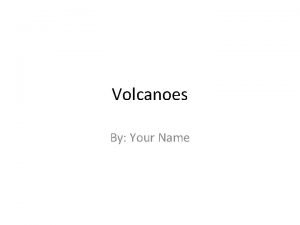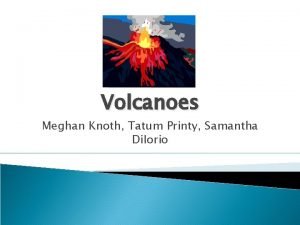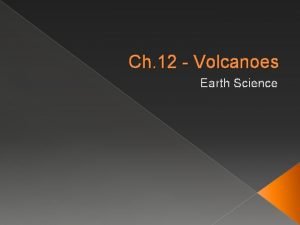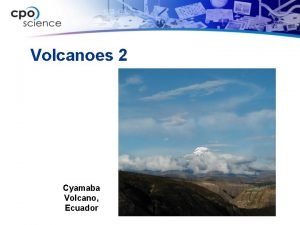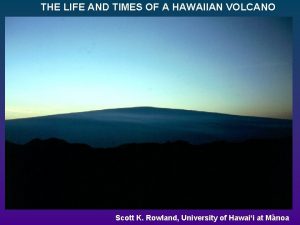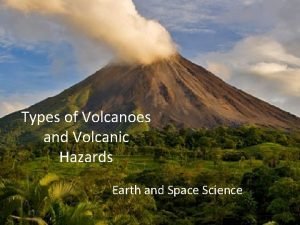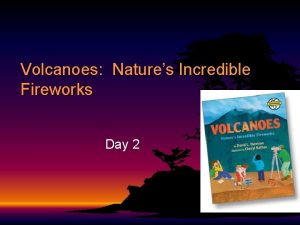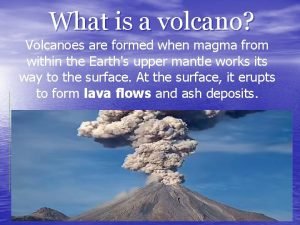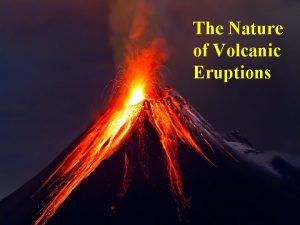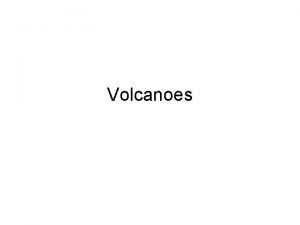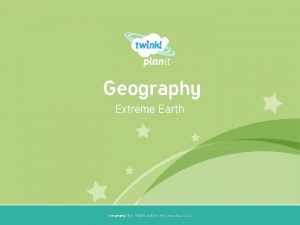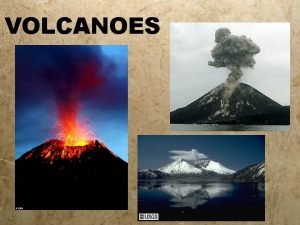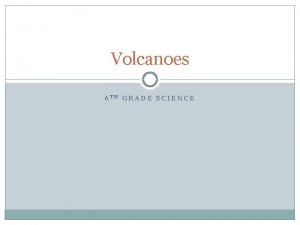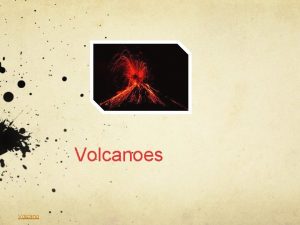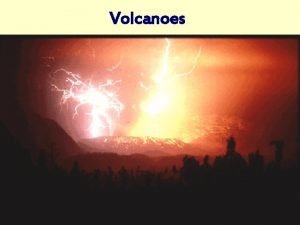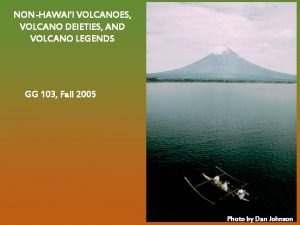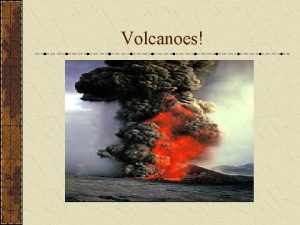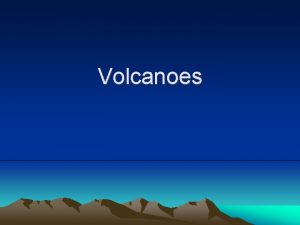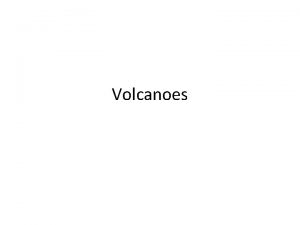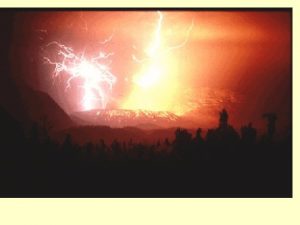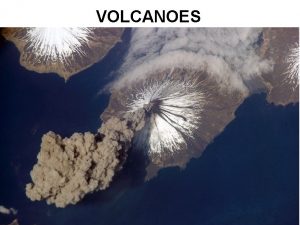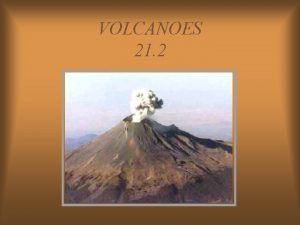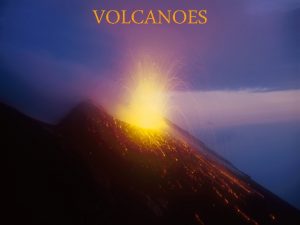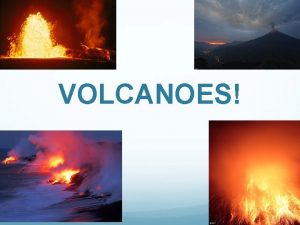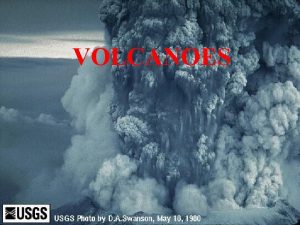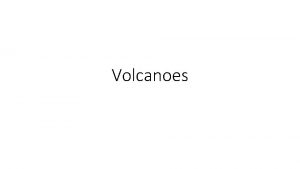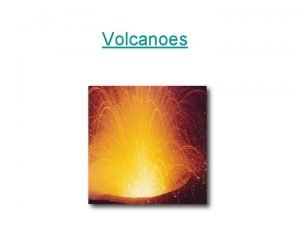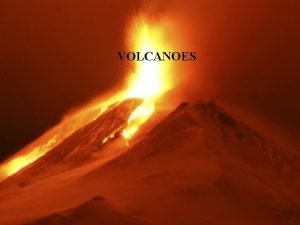Volcanoes What is a Volcano A volcano is
















- Slides: 16

Volcanoes

What is a Volcano? • A volcano is an opening at the Earth’s surface. • Magma, gas and other materials erupt through the opening. • Lava releases from the main vent. • When the lava cools and produces new rocks high in minerals. • Volcanoes can be extinct, dormant or active. ØExtinct – will not erupt again ØDormant – has not erupted in the last 2000 years ØActive – has erupted recently.

Main features of a volcano

How do volcanoes erupt? • Many reasons why volcanoes erupt, but • There are three main reasons: ØBuoyancy of the magma – magma rises to the earth’s crust and erupts. ØPressure of the gases – the more gas in the magma creates an eruption. ØNew magma in the magma chamber – the new magma rises in the main vent and causes an eruption. • Volcanoes are very difficult to predict.

Six main types of Volcanoes on Earth. • Stratovolcanoes (Composite). • Shield Volcanoes • Cinder Cone • Lava Domes • Giant Caldera Volcano • Fissure Volcano

Stratovolcano (Composite) • Has steep sides made from lava, volcanic ash and cinders. • Eruptions may be a pyroclastic flow. • Pyroclastic flow is a combination of rock, ash, steam and dust. • Pyroclastic flow travel at very high speed down the volcano. • Pyroclastic flow temperature exceeds 400 degrees Celsius. • Composite volcanoes can be over 8, 000 feet high (2438. 3 meters). • They are very explosive and a concern for people and property. • Composite volcanoes include: Mount Fuji (Japan), Mount St. Helens and Mount Rainier (Washington). http: //www. cotf. edu/ete/modules/volcanoes/vtypesvolcan 1. html

Shield Volcano • Gentle sloping sides formed from lava. • Eruptions normally non-explosive. • Lava can flow over great distances. • They can have numerous eruptions but are gentle. • Can be 1, 500 to 2, 000 feet high. • Width of 3 or 4 miles. • Can destroy people’s possessions but death or injury is rare. • Can be some of the largest volcanoes in the world. • Shield Volcanoes include: Mount Kilauea and Maunaloa (Hawaii). http: //www. cotf. edu/ete/modules/volcanoes/vtypesvolcan 1. html

Cinder Cone Volcano • Simplest type of volcano • Build from lava components being released from the single vent. • The lava is blown into the air aggressively. • The lava creates a oval shaped cone. • Which then forms a bowl shaped crater at the top. • Cinder Cone volcanoes are about 1, 000 feet high. . • Cinder Cone volcanoes are in most parts of the world but common in North America. • Cinder Cone Volcanoes include: Tumble Buttes, Twin Buttes (California), Ankaizina Feild (Madagascar) and Altlin Valc Feild (Canada). http: //www. cotf. edu/ete/modules/volcanoes/vtypesvolcan 1. html

Dome Volcano • Lava from a Dome Volcano is thicker than lava from a Shield Volcano. • Has steeper sides than a Shield Volcano. • Lava is think and sticky. • Lava cools and hardens quickly so does flow far. • The lava forms around and over the vent. • Eruptions can be destructive. • Dome Volcanoes include: Mount Semeru (Indonesia), Augustine (Alaska) and Barawli (Ethiopia). http: //www. explorevolcanoes. com/Lava%20 Dome. html

Caldera Volcano • Most powerful and tragic volcano. • They are an inverse shaped volcano. • The magma chamber increases size under the ground and forms extreme pressure of gas. • Once the pressure has been released through pyroclastic eruptions, the magma chamber caves in. • Largest on earth measuring a width from 15 - 100 metres. • Caldera Volcanoes include: Toba Eruption (Indonesia), The Yellowstone Caldera in (Wyoming, USA). http: //www. cotf. edu/ete/modules/volcanoes/vtypesvolcan 2. html

Fissure Volcano • No dominate crater. • Fissure volcanoes are only a few metres wide but are kilometres in length. • Giant cracks in the ground which releases lava to extreme distances. • When the lava cools ad hardens, the surface remains flat. • Volcano cracks are buried and difficult to see evidence of a volcano. • Fissure Volcanoes include Los Pilas (Nicaragua), Banda Api volcano (Indonesia) and Krafla volcano (Iceland). http: //www. cotf. edu/ete/modules/volcanoes/vtypesvolcan 2. html

Volcano on Titan • May have cryovolcanoes (ice volcanoes) on Saturn. • They erupts icy liquids such as water, ammonia and hydrocarbons instead of lava. • Can be as high as 1 500 meters and have a depth of 1 500 meters. http: //www. bbc. com/earth/story/20150708 -the-volcanoes-found-in-space

Volcano on Mars • Mars used to have the biggest and best volcanoes in. • The Olympus Mons (pictured) is the biggest volcano in the solar system. • It is 25 kilometres tall and has a width of 624 kilometres. • It is extinct because it has not erupted for millions of years. http: //www. bbc. com/earth/story/20150708 -the-volcanoes-found-in-space

Volcanoes on lo • Lo is one of the large moons on Juniper. • Lo is covered in active volcanoes. • Lo erupts clouds of sulphurous chemicals. • Volcanoes erupt on lo because the interior is very hot. http: //www. bbc. com/earth/story/20150708 -the-volcanoes-found-in-space

Similarities and differences of a volcano on Earth and on Titan.

References BBC. (2015). All the planets and moons known to have volcanoes. Retrieved from http: //www. bbc. com/earth/story/20150708 -the-volcanoes-found-in-space Bioexpedition. (2013). Fissure Vent Volcano. Retrieved from http: //www. basicplanet. com/fissure-vent-volcano/ Extreme Science. (2015). Caldera Volcanoes. Retrieved from http: //www. extremescience. com/calderas. htm Fact Monster. (2013). Types of Volcanoes. Retrieved from http: //www. factmonster. com/ipka/A 0862596. html Internet Geography. (2015). What is a volcano? Retrieved from http: //www. geography. learnontheinternet. co. uk/topics/whatvolcano. html#volint Kilinc, A. (1999). What causes a volcano to erupt and how do scientists predict eruptions? Retrieved from http: //www. scientificamerican. com/article/what-causes-a-volcano-to/ Wall, M. (2010). Ice Volcano Found on Saturn Moon Titan. Retrieved from http: //www. space. com/10486 -ice-volcano-saturnmoon-titan. html Wheeling Jesuit University. (2004). Exploring the Environment Volcanoes. Retrieved from http: //www. cotf. edu/ete/modules/volcanoes/vtypesvolcan 1. html
 Lava plateaus form when _____.
Lava plateaus form when _____. Lava and magma difference
Lava and magma difference How are volcanoes formed
How are volcanoes formed Ecuador
Ecuador A'a hawaiian
A'a hawaiian Types of volcanoes
Types of volcanoes Volcanoes nature's incredible fireworks
Volcanoes nature's incredible fireworks Describe volcano
Describe volcano Types of volcanoes
Types of volcanoes Big island size broad slightly domed
Big island size broad slightly domed Most volcanoes occur __________. *
Most volcanoes occur __________. * How are volcanoes made
How are volcanoes made Volcanoes of italy map
Volcanoes of italy map Ring of fire volcanoes
Ring of fire volcanoes Lithosphere definition
Lithosphere definition How are volcanoes classified
How are volcanoes classified Name volcanoes
Name volcanoes
